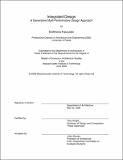Integrated design : a generative multi-performative design approach
Author(s)
Fasoulaki, Eleftheria
DownloadFull printable version (4.621Mb)
Other Contributors
Massachusetts Institute of Technology. Dept. of Architecture.
Advisor
Terry Knight.
Terms of use
Metadata
Show full item recordAbstract
There are building systems, called "modularized", in which the component systems (for structure, lighting, etc) can be analyzed and synthesized independently since their performance and design do not interact or affect one another. There are other building systems, called "coupled", in which the component systems do interact and influence one another. The thesis acknowledges that in a building there are both sub-systems that act independently and others that interact. While many design processes have been proposed for dealing with discrete sub-systems, there is no systematic study for building sub-systems that interrelate. This thesis examines a different design approach called integrated. The term "integrated" has a dual utilization in this study. The first use refers to the integration of form and building performance. The second use refers to the integration of interrelated and diverse building performances involving multiple disciplines. The integrated design approach analyzes and evaluates several interrelated design systems involving different disciplines in the early design phase. The goal of the approach is the generation of design alternatives guided simultaneously by two basic objectives: the aspiration for form exploration and the satisfaction of the performances of interrelated systems. After defining a framework for an integrated design approach, which includes inter-disciplinary collaboration, unified design, optimization, simulation, and other formal and digital techniques, the approach will be demonstrated in a case study. The objective of the case study is to demonstrate that the integrated design approach has validity and can be realized, in this case, for the generation of high-rise buildings guided by structural, lighting, zoning codes, and aesthetic criteria.
Description
Thesis (S.M.)--Massachusetts Institute of Technology, Dept. of Architecture, 2008. This electronic version was submitted by the student author. The certified thesis is available in the Institute Archives and Special Collections. MIT Institute Archives copy: with CD-ROM; divisional library copy with no CD-ROM. Includes bibliographical references (leaves 70-72).
Date issued
2008Department
Massachusetts Institute of Technology. Department of ArchitecturePublisher
Massachusetts Institute of Technology
Keywords
Architecture.